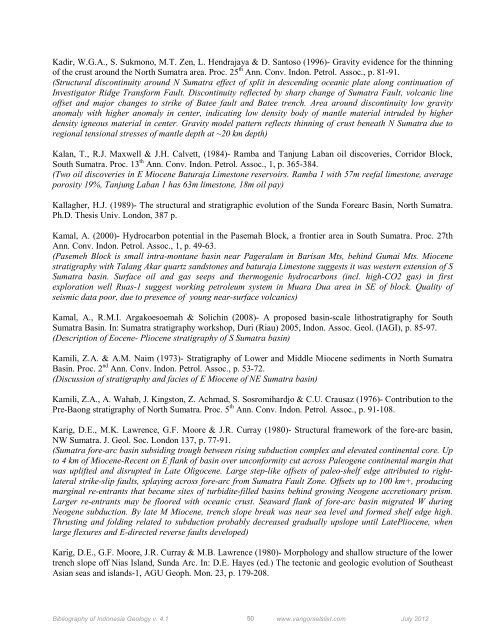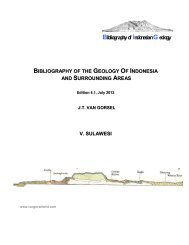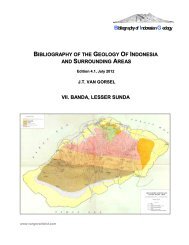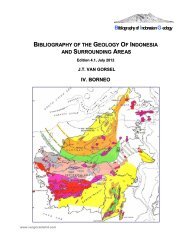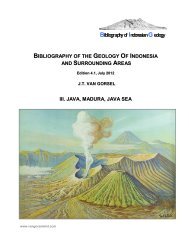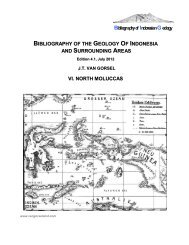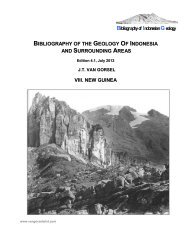Sumatra, Sunda Shelf, Natuna - Bibliography of Indonesia Geology
Sumatra, Sunda Shelf, Natuna - Bibliography of Indonesia Geology
Sumatra, Sunda Shelf, Natuna - Bibliography of Indonesia Geology
You also want an ePaper? Increase the reach of your titles
YUMPU automatically turns print PDFs into web optimized ePapers that Google loves.
Kadir, W.G.A., S. Sukmono, M.T. Zen, L. Hendrajaya & D. Santoso (1996)- Gravity evidence for the thinning<br />
<strong>of</strong> the crust around the North <strong>Sumatra</strong> area. Proc. 25 th Ann. Conv. Indon. Petrol. Assoc., p. 81-91.<br />
(Structural discontinuity around N <strong>Sumatra</strong> effect <strong>of</strong> split in descending oceanic plate along continuation <strong>of</strong><br />
Investigator Ridge Transform Fault. Discontinuity reflected by sharp change <strong>of</strong> <strong>Sumatra</strong> Fault, volcanic line<br />
<strong>of</strong>fset and major changes to strike <strong>of</strong> Batee fault and Batee trench. Area around discontinuity low gravity<br />
anomaly with higher anomaly in center, indicating low density body <strong>of</strong> mantle material intruded by higher<br />
density igneous material in center. Gravity model pattern reflects thinning <strong>of</strong> crust beneath N <strong>Sumatra</strong> due to<br />
regional tensional stresses <strong>of</strong> mantle depth at ~20 km depth)<br />
Kalan, T., R.J. Maxwell & J.H. Calvett, (1984)- Ramba and Tanjung Laban oil discoveries, Corridor Block,<br />
South <strong>Sumatra</strong>. Proc. 13 th Ann. Conv. Indon. Petrol. Assoc., 1, p. 365-384.<br />
(Two oil discoveries in E Miocene Baturaja Limestone reservoirs. Ramba 1 with 57m reefal limestone, average<br />
porosity 19%, Tanjung Laban 1 has 63m limestone, 18m oil pay)<br />
Kallagher, H.J. (1989)- The structural and stratigraphic evolution <strong>of</strong> the <strong>Sunda</strong> Forearc Basin, North <strong>Sumatra</strong>.<br />
Ph.D. Thesis Univ. London, 387 p.<br />
Kamal, A. (2000)- Hydrocarbon potential in the Pasemah Block, a frontier area in South <strong>Sumatra</strong>. Proc. 27th<br />
Ann. Conv. Indon. Petrol. Assoc., 1, p. 49-63.<br />
(Pasemeh Block is small intra-montane basin near Pageralam in Barisan Mts, behind Gumai Mts. Miocene<br />
stratigraphy with Talang Akar quartz sandstones and baturaja Limestone suggests it was western extension <strong>of</strong> S<br />
<strong>Sumatra</strong> basin. Surface oil and gas seeps and thermogenic hydrocarbons (incl. high-CO2 gas) in first<br />
exploration well Ruas-1 suggest working petroleum system in Muara Dua area in SE <strong>of</strong> block. Quality <strong>of</strong><br />
seismic data poor, due to presence <strong>of</strong> young near-surface volcanics)<br />
Kamal, A., R.M.I. Argakoesoemah & Solichin (2008)- A proposed basin-scale lithostratigraphy for South<br />
<strong>Sumatra</strong> Basin. In: <strong>Sumatra</strong> stratigraphy workshop, Duri (Riau) 2005, Indon. Assoc. Geol. (IAGI), p. 85-97.<br />
(Description <strong>of</strong> Eocene- Pliocene stratigraphy <strong>of</strong> S <strong>Sumatra</strong> basin)<br />
Kamili, Z.A. & A.M. Naim (1973)- Stratigraphy <strong>of</strong> Lower and Middle Miocene sediments in North <strong>Sumatra</strong><br />
Basin. Proc. 2 nd Ann. Conv. Indon. Petrol. Assoc., p. 53-72.<br />
(Discussion <strong>of</strong> stratigraphy and facies <strong>of</strong> E Miocene <strong>of</strong> NE <strong>Sumatra</strong> basin)<br />
Kamili, Z.A., A. Wahab, J. Kingston, Z. Achmad, S. Sosromihardjo & C.U. Crausaz (1976)- Contribution to the<br />
Pre-Baong stratigraphy <strong>of</strong> North <strong>Sumatra</strong>. Proc. 5 th Ann. Conv. Indon. Petrol. Assoc., p. 91-108.<br />
Karig, D.E., M.K. Lawrence, G.F. Moore & J.R. Curray (1980)- Structural framework <strong>of</strong> the fore-arc basin,<br />
NW <strong>Sumatra</strong>. J. Geol. Soc. London 137, p. 77-91.<br />
(<strong>Sumatra</strong> fore-arc basin subsiding trough between rising subduction complex and elevated continental core. Up<br />
to 4 km <strong>of</strong> Miocene-Recent on E flank <strong>of</strong> basin over unconformity cut across Paleogene continental margin that<br />
was uplifted and disrupted in Late Oligocene. Large step-like <strong>of</strong>fsets <strong>of</strong> paleo-shelf edge attributed to rightlateral<br />
strike-slip faults, splaying across fore-arc from <strong>Sumatra</strong> Fault Zone. Offsets up to 100 km+, producing<br />
marginal re-entrants that became sites <strong>of</strong> turbidite-filled basins behind growing Neogene accretionary prism.<br />
Larger re-entrants may be floored with oceanic crust. Seaward flank <strong>of</strong> fore-arc basin migrated W during<br />
Neogene subduction. By late M Miocene, trench slope break was near sea level and formed shelf edge high.<br />
Thrusting and folding related to subduction probably decreased gradually upslope until LatePliocene, when<br />
large flexures and E-directed reverse faults developed)<br />
Karig, D.E., G.F. Moore, J.R. Curray & M.B. Lawrence (1980)- Morphology and shallow structure <strong>of</strong> the lower<br />
trench slope <strong>of</strong>f Nias Island, <strong>Sunda</strong> Arc. In: D.E. Hayes (ed.) The tectonic and geologic evolution <strong>of</strong> Southeast<br />
Asian seas and islands-1, AGU Geoph. Mon. 23, p. 179-208.<br />
<strong>Bibliography</strong> <strong>of</strong> <strong>Indonesia</strong> <strong>Geology</strong> v. 4.1 50 www.vangorselslist.com July 2012


